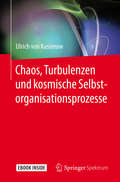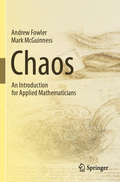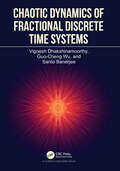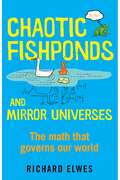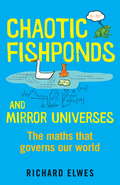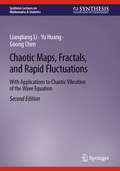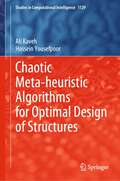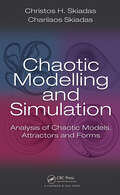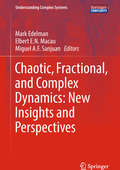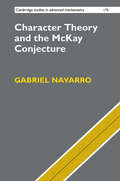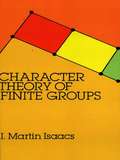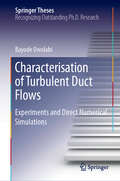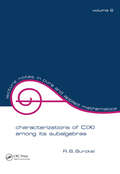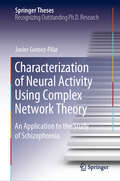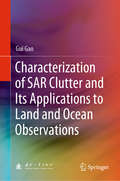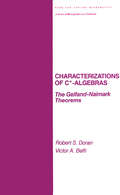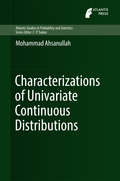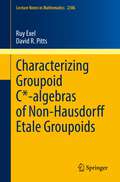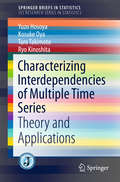- Table View
- List View
Chaos, Turbulenzen und kosmische Selbstorganisationsprozesse
by Ulrich Von KusserowDieses Buch bietet eine anschauliche und reich bebilderte Übersicht zur Vielfalt kosmischer Turbulenz- und Selbstorganisationsszenarien und ermöglicht umfassende Einblicke in die dabei in ganz unterschiedlichen Zusammenhängen ablaufenden Vorgänge und zugrundeliegenden theoretischen Konzepte. Es richtet sich an fachwissenschaftlich interessierte Laien, Studenten und Wissenschaftler, die einen Einstieg in diese Themenbereiche suchen. Der Autor zeigt auf, nach welchen Gesetzen Selbstorganisationsprozesse überall im Kosmos insbesondere auch die Entstehung der Galaxien, Sterne und Planeten sowie die Entwicklung des Lebens auf dem Planeten Erde möglich gemacht haben. In ansprechender Weise schlägt er einen weiten Bogen über eine Vielzahl chaotischer Vorgänge und Turbulenzen, geordneter Strukturbildungs- und Entwicklungsprozesse in der Natur, die uns Menschen aus dem Alltagsleben teilweise sehr wohl bekannt sind. Die näheren Erläuterungen mathematisch-physikalischer Modellierungsansätze und wissenschaftlicher Forschungsmethoden ermöglichen dem Leser ein wesentlich grundlegenderes Verständnis der dabei Einfluss nehmenden physikalischen, chemischen und biologischen Prozesse.
Chaos, dynamics, and fractals
by Joseph L. MccauleyThis book develops deterministic chaos and fractals from the standpoint of iterated maps, but the emphasis makes it very different from all other books in the field. It provides the reader with an introduction to more recent developments, such as weak universality, multifractals, and shadowing, as well as to older subjects like universal critical exponents, devil's staircases and the Farey tree. The author uses a fully discrete method, a â theoretical computer arithmetic', because finite (but not fixed) precision cannot be avoided in computation or experiment. This leads to a more general formulation in terms of symbolic dynamics and to the idea of weak universality. The connection is made with Turing's ideas of computable numbers and it is explained why the continuum approach leads to predictions that are not necessarily realized in computation or in nature, whereas the discrete approach yields all possible histograms that can be observed or computed.
Chaos: An Introduction for Applied Mathematicians
by Andrew Fowler Mark McGuinnessThis is a textbook on chaos and nonlinear dynamics, written by applied mathematicians for applied mathematicians. It aims to tread a middle ground between the mathematician's rigour and the physicist’s pragmatism.While the subject matter is now classical and can be found in many other books, what distinguishes this book is its philosophical approach, its breadth, its conciseness, and its exploration of intellectual byways, as well as its liberal and informative use of illustration. Written at the graduate student level, the book occasionally drifts from classical material to explore new avenues of thought, sometimes in the exercises. A key feature of the book is its holistic approach, encompassing the development of the subject since the time of Poincaré, and including detailed material on maps, homoclinic bifurcations, Hamiltonian systems, as well as more eclectic items such as Julia and Mandelbrot sets. Some of the more involved codes to produce the figures are described in the appendix.Based on lectures to upper undergraduates and beginning graduate students, this textbook is ideally suited for courses at this level and each chapter includes a set of exercises of varying levels of difficulty.
Chaos: The World of Nonperiodic Oscillations (Understanding Complex Systems #Vol. 84)
by Otto E. Rössler Christophe LetellierWritten in the 1980s by one of the fathers of chaos theory, Otto E. Rössler, the manuscript presented in this volume eventually never got published. Almost 40 years later, it remains astonishingly at the forefront of knowledge about chaos theory and many of the examples discussed have never been published elsewhere. The manuscript has now been edited by Christophe Letellier - involved in chaos theory for almost three decades himself, as well as being active in the history of sciences - with a minimum of changes to the original text.Finally released for the benefit of specialists and non-specialists alike, this book is equally interesting from the historical and the scientific points of view: an unconventionally modern approach to chaos theory, it can be read as a classic introduction and short monograph as well as a collection of original insights into advanced topics from this field.
Chaotic Dynamics in Nonlinear Theory
by Lakshmi BurraUsing phase-plane analysis, findings from the theory of topological horseshoes and linked-twist maps, this book presents a novel method to prove the existence of chaotic dynamics. In dynamical systems, complex behavior in a map can be indicated by showing the existence of a Smale-horseshoe-like structure, either for the map itself or its iterates. This usually requires some assumptions about the map, such as a diffeomorphism and some hyperbolicity conditions. In this text, less stringent definitions of a horseshoe have been suggested so as to reproduce some geometrical features typical of the Smale horseshoe, while leaving out the hyperbolicity conditions associated with it. This leads to the study of the so-called topological horseshoes. The presence of chaos-like dynamics in a vertically driven planar pendulum, a pendulum of variable length, and in other more general related equations is also proved.
Chaotic Dynamics in Planetary Systems (Springer Praxis Books)
by Sylvio Ferraz-MelloThe main theme of the book is the presentation of techniques used to identify chaotic behavior in the evolution of conservative mechanical systems and their application to astronomical systems. It results from graduate courses given by the author over the years both at university and at several international summer schools.Along the book surfaces of section, Lyapunov characteristic exponents, frequency maps, MEGNO, dense grid maps, etc., are presented and discussed in connection with the applications. The initial chapter is devoted to the presentation of the main ideas of the chaotic dynamics of conservative systems in plain language so that they can be accessible to a wide range of professionals and students of physical sciences. The applications are mainly related to the motions in the solar system and extrasolar planetary systems.Another chapter is devoted to the applications to asteroids showing how the asteroidal belt is sculpted by chaos and resonances. The contrasting existence of gaps in the distribution of the asteroids and groups of asteroids in resonances is thoroughly discussed. The interest in applications to planetary systems is growing since the discovery of systems of resonant planets around some stars of the solar neighborhood. Exoplanets added a lot of cases to a problem that was before restricted to the planets of our solar system. The book includes an account of results already existing about compact systems.
Chaotic Dynamics of Fractional Discrete Time Systems
by Santo Banerjee Vignesh Dhakshinamoorthy Guo-Cheng WuThe book reviews the application of discrete fractional operators in diverse fields such as biological and chemical reactions, as well as chaotic systems, demonstrating their applications in physics. The dynamical analysis is carried out using equilibrium points of the system for studying their stability properties and the chaotic behaviors are illustrated with the help of bifurcation diagrams and Lyapunov exponents.The book is divided into three parts. Part I deals with the application of discrete fractional operators in chemical reaction-based systems with biological significance. Two different chemical reaction models are analysed- one being disproportionation of glucose, which plays an important role in human physiology and the other is the Lengyel – Epstein chemical model. Chaotic behavior of the systems is studied and the synchronization of the system is performed. Part II covers the analysis of biological systems like tumor immune system and neuronal models by introducing memristor based flux control. The memductance functions are considered as quadratic, periodic, and exponential functions. The final part of the book reviews the complex form of the Rabinovich-Fabrikant system which describes physical systems with strong nonlinearity exhibiting unusual behavior.
Chaotic Fishponds and Mirror Universes: The Strange Math Behind the Modern World
by Richard ElwesChaotic Fishponds and Mirror Universes explains how mathematics determines every aspect of our lives--right down to the foundations of our bodies. Math is everywhere, whether we are aware of it or not. What can we learn from fish in a pond? How do social networks connect the world? How can artificial intelligences learn? How can math make you a better liar? Exploring math through 35 of its odd and often unexpected applications, this book provides an insight into the 'hidden wiring' that governs our world.
Chaotic Fishponds and Mirror Universes: The Strange Maths Behind the Modern World
by Richard ElwesWhat can we learn from fish in a pond? How do social networks connect the world? How can artificial intelligences learn? Why would life be different in a mirror universe? Mathematics is everywhere, whether we are aware of it or not. Exploring the subject through 35 of its often odd and unexpected applications, this book provides an insight into the 'hidden wiring' that governs our world. From the astonishing theorems that control computers to the formulae behind stocks and shares, and from the foundations of the internet to the maths behind medical imaging, Chaotic Fishponds and Mirror Universes explains how mathematics determines every aspect of our lives - right down to the foundations of our bodies.
Chaotic Fishponds and Mirror Universes: The Strange Maths Behind the Modern World
by Richard ElwesWhat can we learn from fish in a pond? How do social networks connect the world? How can artificial intelligences learn? Why would life be different in a mirror universe? Mathematics is everywhere, whether we are aware of it or not. Exploring the subject through 35 of its often odd and unexpected applications, this book provides an insight into the 'hidden wiring' that governs our world. From the astonishing theorems that control computers to the formulae behind stocks and shares, and from the foundations of the internet to the maths behind medical imaging, Chaotic Fishponds and Mirror Universes explains how mathematics determines every aspect of our lives - right down to the foundations of our bodies.
Chaotic Maps, Fractals, and Rapid Fluctuations: With Applications to Chaotic Vibration of the Wave Equation (Synthesis Lectures on Mathematics & Statistics)
by Yu Huang Goong Chen Liangliang LiThis book was developed from lecture notes for an introductory graduate course and provides an essential introduction to chaotic maps in finite-dimensional spaces. Furthermore, the authors show how to apply this theory to infinite-dimensional systems corresponding to partial differential equations to study chaotic vibration of the wave equation subject to various types of nonlinear boundary conditions. The book provides background on chaos as a highly interesting nonlinear phenomenon and explains why it is one of the most important scientific findings of the past three decades. In addition, the book covers key topics including one-dimensional dynamical systems, bifurcations, general topological, symbolic dynamical systems, and fractals. The authors also show a class of infinite-dimensional nonlinear dynamical systems, which are reducible to interval maps, plus rapid fluctuations of chaotic maps. This second edition includes updated and expanded chapters as well as additional problems.
Chaotic Meta-heuristic Algorithms for Optimal Design of Structures (Studies in Computational Intelligence #1129)
by Ali Kaveh Hossein YousefpoorIn this book, various chaos maps are embedded in eleven efficient and well-known metaheuristics and a significant improvement in the optimization results is achieved. The two basic steps of metaheuristic algorithms consist of exploration and exploitation. The imbalance between these stages causes serious problems for metaheuristic algorithms, which are immature convergence and stopping in local optima. Chaos maps with chaotic jumps can save algorithms from being trapped in local optima and lead to convergence toward global optima. Embedding these maps in the exploration phase, exploitation phase, or both simultaneously corresponds to three efficient and useful scenarios. By creating competition between different modes and increasing diversity in the search space and creating sudden jumps in the search phase, improvements are achieved for chaotic algorithms. Four Chaotic Algorithms, including Chaotic Cyclical Parthenogenesis Algorithm, Chaotic Water Evaporation Optimization, Chaotic Tug-of-War Optimization, and Chaotic Thermal Exchange Optimization are developed.
Chaotic Modelling and Simulation: Analysis of Chaotic Models, Attractors and Forms
by Christos H. Skiadas Charilaos SkiadasOffers Both Standard and Novel Approaches for the Modeling of SystemsExamines the Interesting Behavior of Particular Classes of ModelsChaotic Modelling and Simulation: Analysis of Chaotic Models, Attractors and Forms presents the main models developed by pioneers of chaos theory, along with new extensions and variations of these models. Using more
Chaotic, Fractional, and Complex Dynamics: New Insights and Perspectives (Understanding Complex Systems)
by Miguel A. F. Sanjuan Mark Edelman Elbert E. N. MacauThe book presents nonlinear, chaotic and fractional dynamics, complex systems and networks, together with cutting-edge research on related topics. The fifteen chapters - written by leading scientists working in the areas of nonlinear, chaotic, and fractional dynamics, as well as complex systems and networks - offer an extensive overview of cutting-edge research on a range of topics, including fundamental and applied research. These include but are not limited to, aspects of synchronization in complex dynamical systems, universality features in systems with specific fractional dynamics, and chaotic scattering. As such, the book provides an excellent and timely snapshot of the current state of research, blending the insights and experiences of many prominent researchers.
Character Theory and the McKay Conjecture (Cambridge Studies in Advanced Mathematics #175)
by Gabriel NavarroThe McKay conjecture is the origin of the counting conjectures in the representation theory of finite groups. <P><P>This book gives a comprehensive introduction to these conjectures, while assuming minimal background knowledge. Character theory is explored in detail along the way, from the very basics to the state of the art. This includes not only older theorems, but some brand new ones too. <P>New, elegant proofs bring the reader up to date on progress in the field, leading to the final proof that if all finite simple groups satisfy the inductive McKay condition, then the McKay conjecture is true. Open questions are presented throughout the book, and each chapter ends with a list of problems, with varying degrees of difficulty.<P> Written by one of the world leaders in the field.<P> Gives a comprehensive overview of the subject, including descriptions of related results at the end of each chapter.<P> Brings together for the first time results that were spread throughout the literature.
Character Theory of Finite Groups
by I. Martin Isaacs"The book is a pleasure to read. There is no question but that it will become, and deserves to be, a widely used textbook and reference." -- Bulletin of the American Mathematical Society.Character theory provides a powerful tool for proving theorems about finite groups. In addition to dealing with techniques for applying characters to "pure" group theory, a large part of this book is devoted to the properties of the characters themselves and how these properties reflect and are reflected in the structure of the group.Chapter I consists of ring theoretic preliminaries. Chapters 2 to 6 and 8 contain the basic material of character theory, while Chapter 7 treats an important technique for the application of characters to group theory. Chapter 9 considers irreducible representations over arbitrary fields, leading to a focus on subfields of the complex numbers in Chapter 10. In Chapter 15 the author introduces Brauer's theory of blocks and "modular characters." Remaining chapters deal with more specialized topics, such as the connections between the set of degrees of the irreducible characters and structure of a group. Following each chapter is a selection of carefully thought out problems, including exercises, examples, further results and extensions and variations of theorems in the text.Prerequisites for this book are some basic finite group theory: the Sylow theorems, elementary properties of permutation groups and solvable and nilpotent groups. Also useful would be some familiarity with rings and Galois theory. In short, the contents of a first-year graduate algebra course should be sufficient preparation.
Characterisation of Turbulent Duct Flows: Experiments and Direct Numerical Simulations (Springer Theses)
by Bayode OwolabiThis book presents several new findings in the field of turbulent duct flows, which are important for a range of industrial applications. It presents both high-quality experiments and cutting-edge numerical simulations, providing a level of insight and rigour rarely found in PhD theses. The scientific advancements concern the effect of the Earth’s rotation on large duct flows, the experimental confirmation of marginal turbulence in a pressure-driven square duct flow (previously only predicted in simulations), the identification of similar marginal turbulence in wall-driven flows using simulations (for the first time by any means) and, on a separate but related topic, a comprehensive experimental study on the phenomenon of drag reduction via polymer additives in turbulent duct flows. In turn, the work on drag reduction resulted in a correlation that provides a quantitative prediction of drag reduction based on a single, measurable material property of the polymer solution, regardless of the flow geometry or concentration. The first correlation of its kind, it represents an important advancement from both a scientific and practical perspective.
Characterization of C(x) among its Subalgebras
by R. B. BurckelThis book presents a detailed account of some results about subalgebras of C(X), which carry a Banach algebra norm. It is intended for students who have had a standard graduate real-variable course and be acquainted with a few odds and ends of functional analysis and complex-variables.
Characterization of Neural Activity Using Complex Network Theory: An Application to the Study of Schizophrenia (Springer Theses)
by Javier Gomez-PilarThis book reports on the development and assessment of a novel framework for studying neural interactions (the connectome) and their dynamics (the chronnectome). Using EEG recordings taken during an auditory oddball task performed by 48 patients with schizophrenia and 87 healthy controls, and applying local and network measures, changes in brain activation from pre-stimulus to cognitive response were assessed, and significant differences were observed between the patients and controls. This book investigates the source of the network abnormalities and presents new evidence for the disconnection hypothesis and the aberrant salience hypothesis with regard to schizophrenia. Moreover, it puts forward a novel approach to combining local regularity measures and graph measures in order to characterize schizophrenia brain dynamics, and presents interesting findings on the regularity of brain patterns in healthy control subjects versus patients with schizophrenia. Besides providing new evidence for the disconnection hypothesis, it offers a source of inspiration for future research directions in the field.
Characterization of SAR Clutter and Its Applications to Land and Ocean Observations
by Gui GaoThis book discusses statistical modeling of single- and multi-channel synthetic aperture radar (SAR) images and the applications of these newly developed models in land and ocean monitoring, such as target detection and terrain classification. It is a valuable reference for researchers and engineers interested in information processing of remote sensing, radar signal processing, and image interpretation.
Characterizations of C* Algebras: the Gelfand Naimark Theorems
by Robert DoranThe first unified, in-depth discussion of the now classical Gelfand-Naimark theorems, thiscomprehensive text assesses the current status of modern analysis regarding both Banachand C*-algebras.Characterizations of C*-Algebras: The Gelfand-Naimark Theorems focuses on general theoryand basic properties in accordance with readers' needs ... provides complete proofs of theGelfand-Naimark theorems as well as refinements and extensions of the original axioms. . . gives applications of the theorems to topology, harmonic analysis. operator theory.group representations, and other topics ... treats Hermitian and symmetric *-algebras.algebras with and without identity, and algebras with arbitrary (possibly discontinuous)involutions . . . includes some 300 end-of-chapter exercises . . . offers appendices on functionalanalysis and Banach algebras ... and contains numerous examples and over 400 referencesthat illustrate important concepts and encourage further research.Characterizations of C*-Algebras: The Gelfand-Naimark Theorems is an ideal text for graduatestudents taking such courses as The Theory of Banach Algebras and C*-Algebras: inaddition , it makes an outstanding reference for physicists, research mathematicians in analysis,and applied scientists using C*-algebras in such areas as statistical mechanics, quantumtheory. and physical chemistry.
Characterizations of Univariate Continuous Distributions (Atlantis Studies in Probability and Statistics #7)
by Mohammad AhsanullahProvides in an organized manner characterizations of univariate probability distributions with many new results published in this area since the 1978 work of Golambos & Kotz "Characterizations of Probability Distributions" (Springer), together with applications of the theory in model fitting and predictions.
Characterizing Groupoid C*-algebras of Non-Hausdorff Étale Groupoids (Lecture Notes in Mathematics #2306)
by Ruy Exel David R. PittsThis book develops tools to handle C*-algebras arising as completions of convolution algebras of sections of line bundles over possibly non-Hausdorff groupoids. A fundamental result of Gelfand describes commutative C*-algebras as continuous functions on locally compact Hausdorff spaces. Kumjian, and later Renault, showed that Gelfand's result can be extended to include non-commutative C*-algebras containing a commutative C*-algebra. In their setting, the C*-algebras in question may be described as the completion of convolution algebras of functions on twisted Hausdorff groupoids with respect to a certain norm. However, there are many natural settings in which the Kumjian–Renault theory does not apply, in part because the groupoids which arise are not Hausdorff. In fact, non-Hausdorff groupoids have been a source of surprising counterexamples and technical difficulties for decades. Including numerous illustrative examples, this book extends the Kumjian–Renault theory to a much broader class of C*-algebras. This work will be of interest to researchers and graduate students in the area of groupoid C*-algebras, the interface between dynamical systems and C*-algebras, and related fields.
Characterizing Interdependencies of Multiple Time Series: Theory and Applications (SpringerBriefs in Statistics)
by Yuzo Hosoya Kosuke Oya Taro Takimoto Ryo KinoshitaThis book introduces academic researchers and professionals to the basic concepts and methods for characterizing interdependencies of multiple time series in the frequency domain. Detecting causal directions between a pair of time series and the extent of their effects, as well as testing the non existence of a feedback relation between them, have constituted major focal points in multiple time series analysis since Granger introduced the celebrated definition of causality in view of prediction improvement. Causality analysis has since been widely applied in many disciplines. Although most analyses are conducted from the perspective of the time domain, a frequency domain method introduced in this book sheds new light on another aspect that disentangles the interdependencies between multiple time series in terms of long-term or short-term effects, quantitatively characterizing them. The frequency domain method includes the Granger noncausality test as a special case. Chapters 2 and 3 of the book introduce an improved version of the basic concepts for measuring the one-way effect, reciprocity, and association of multiple time series, which were originally proposed by Hosoya. Then the statistical inferences of these measures are presented, with a focus on the stationary multivariate autoregressive moving-average processes, which include the estimation and test of causality change. Empirical analyses are provided to illustrate what alternative aspects are detected and how the methods introduced here can be conveniently applied. Most of the materials in Chapters 4 and 5 are based on the authors' latest research work. Subsidiary items are collected in the Appendix.
Characters and Blocks of Solvable Groups: A User’s Guide to Large Orbit Theorems (Synthesis Lectures on Mathematics & Statistics)
by Yong Yang James CosseyThis book highlights recent developments in the representation theory of finite solvable groups, which seeks to connect group theory to linear algebra in ways that allow for better study of the groups in question. Over the last several decades, a number of results in the representations of solvable groups have been proven using so-called “large orbit” theorems. This book provides an extensive survey of the current state of the large-orbit theorems. The authors outline the proofs of the large orbit theorems to provide an overview of the topic, then demonstrate how these theorems can be used to prove new results about solvable groups.
